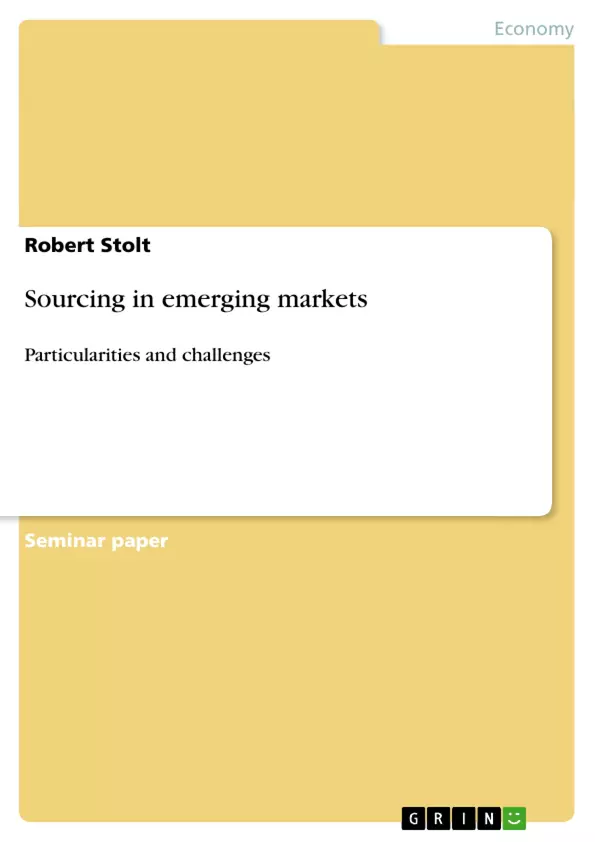Table of Contents
List of Abbreviations i
List of Figures and Tables ii
1 Introduction 1
1.1 Problem Formulation and Objectives 1
1.2 Course of the Investigation 2
2 Characteristics of Sourcing 3
2.1 The Global Sourcing Theory 3
2.2 The Sourcing Process 4
3 Emerging Markets - Risks and Opportunities of Global Sourcing 7
4 Case Study in Global Sourcing – The Jungheinrich AG 11
Concluding Remarks and Outlook 13
Reference List 15
List of Appendixes 19
Appendix 20
Honourable Declaration 22
1 Introduction
1.1 Problem Formulation and Objectives
Global sourcing or sourcing in emerging markets per se is becoming more and more influential, and is a crucial factor of success in many companies. Globalisation is certainly one of the most outstanding phenomena in our today’s world.
[...]
Especially German companies are facing a multitude of obstacles in their domestic market: High salaries and non-wage labour costs, market saturation and elevated production costs, associated with rising product prices, as well as increasing market dynamism and competi-tiveness forcing the companies to constantly adapt to those changes.
Many companies have thus seen an opportunity in global sourcing and moved to emerging market economies (EMEs) in the search for reducing their costs (Heakal, 2003).
The foremost reason why those companies move to aspiring markets like China, India, South-East Asia, Eastern Europe or Latin America are the lower wholesale prices in those countries (Kalkowsky, 2006). However, most firms have a different approach to the sourc-ing process and consequently varying success amongst them.
This study investigates the strategic challenges of German retail companies in conducting and balancing their sourcing activities in order to respond to the particularities and chal-lenges of specific emerging markets. At the same time an analysis on sourcing process op-erations and structures, together with risks and opportunities of different markets is carried out.
Inhaltsverzeichnis (Table of Contents)
- Introduction
- Problem Formulation and Objectives
- Course of the Investigation
- Characteristics of Sourcing
- The Global Sourcing Theory
- The Sourcing Process
- Emerging Markets - Risks and Opportunities of Global Sourcing
- Case Study in Global Sourcing – The Jungheinrich AG
Zielsetzung und Themenschwerpunkte (Objectives and Key Themes)
This seminar paper explores the intricacies of sourcing in emerging markets, examining the specific challenges and opportunities presented by these dynamic economies. The study aims to provide a comprehensive understanding of the global sourcing process, particularly within the context of emerging markets.
- The global sourcing theory and its application in emerging markets.
- The key steps and considerations in the sourcing process.
- The unique risks and opportunities associated with sourcing from emerging markets.
- Case study analysis to illustrate the practicalities of global sourcing.
- The impact of globalization and market dynamics on sourcing strategies.
Zusammenfassung der Kapitel (Chapter Summaries)
The paper begins with an introduction outlining the importance of global sourcing in today's business environment, emphasizing the growing influence of emerging markets. The introduction highlights the key factors driving this trend, including technological advancements, market liberalization, and the desire for cost reduction.
The following chapter delves into the characteristics of sourcing, exploring the theoretical framework of global sourcing and outlining the crucial steps involved in the sourcing process. This section lays the foundation for understanding the complexities of sourcing decisions.
The subsequent chapter focuses on the unique risks and opportunities presented by emerging markets for global sourcing activities. This chapter analyzes the potential benefits and challenges associated with operating within these dynamic environments. It also explores the implications of globalization and market dynamics for sourcing strategies.
Schlüsselwörter (Keywords)
This paper focuses on the key concepts and terms related to global sourcing in emerging markets, encompassing topics such as global sourcing theory, sourcing process, emerging market economies, risks and opportunities, case study analysis, and globalization. It also explores the impact of market dynamics and technological advancements on sourcing strategies, highlighting the importance of careful consideration of diverse factors in successful sourcing decisions.
- Arbeit zitieren
- Robert Stolt (Autor:in), 2007, Sourcing in emerging markets, München, GRIN Verlag, https://www.grin.com/document/83786



